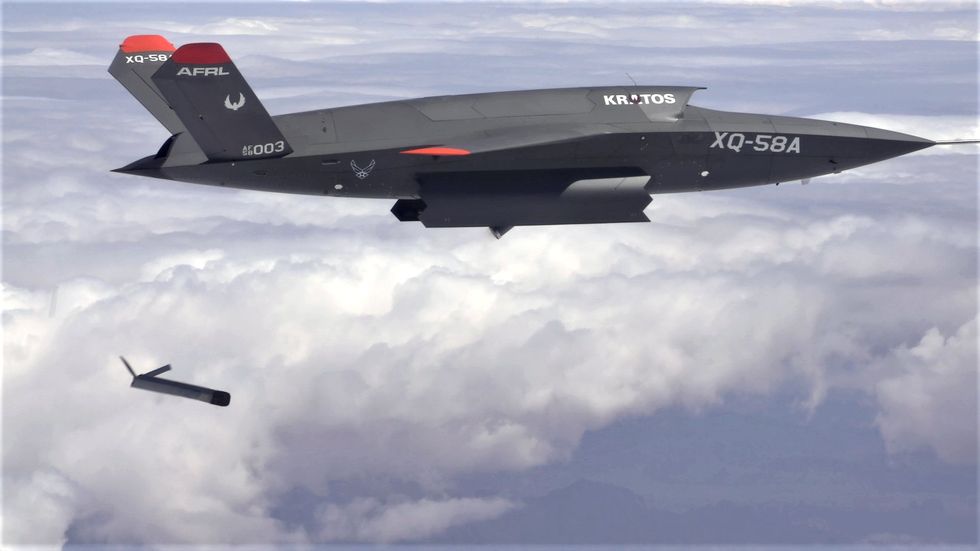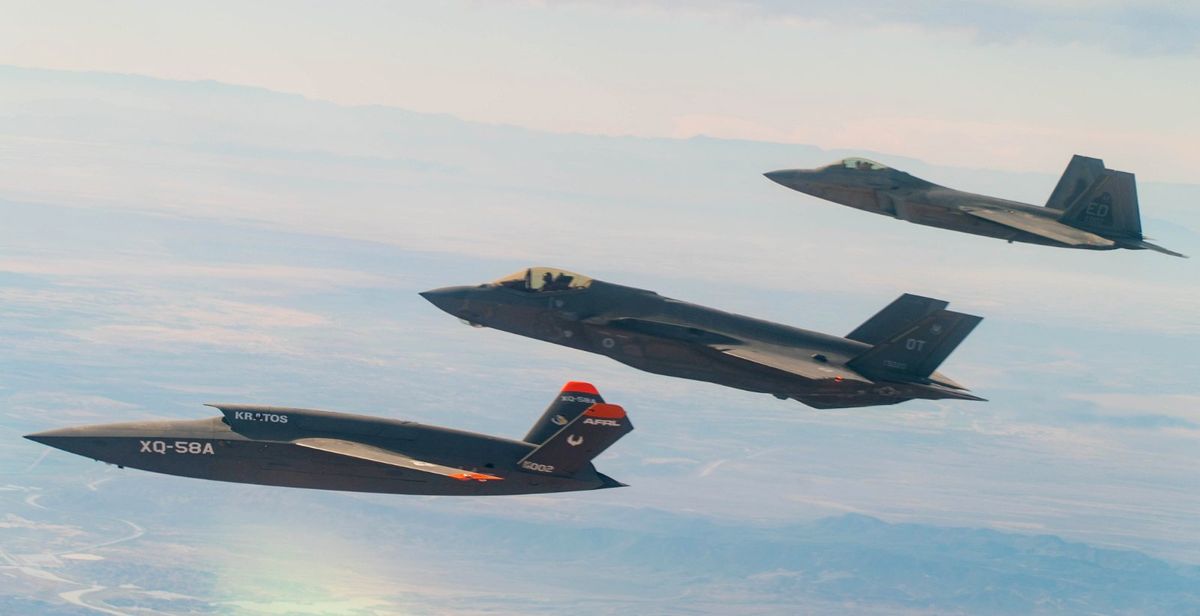Early chess computers were better than grandmasters at calculation but worse in judgement, and so the idea arose to pair them to get the best of both worlds. It worked, but not for long: Computers finally got too good to need human advice.
Are we now at that sweet spot in aerial warfare where human-machine collaborations still make sense? That’s the “loyal wingman” concept, where a human pilot supervises a flock of relatively inexpensive but AI-guided drones. Together, they might overpower enemy fighters in a dogfight. Alternatively, the drones might rush ahead, into airspace too well defended to risk the pilot’s life or the jet.
Many countries are now pursuing the concept, among them Australia, China, India, Japan, Russia, and the United States. Now the U.S. Air Force is preparing to move beyond the tentative stages of research to what’s known as a program of record. That means having an operational concept, a chosen contractor, a sizable production line and a line of funding. The USAF is asking Congress for U.S. $5.8 billion over five years.
Isn’t millions of dollars still a lot of money, compared to the drones now flying over Russia and Ukraine, some reportedly made of cardboard?
This earmark surfaced in reporting this week in The New York Times, focusing particularly on the XQ-58A Valkyrie, an AI-enabled drone made by Kratos Defense & Security Solutions. Other companies in the race include General Atomics, maker of such large attack drones as the Predator and the Reaper and Boeing Australia, maker of the MQ-28 Ghost Bat. (IEEE Spectrum covered that project back in 2020, when it was called the Airpower Teaming System.)
What the Valkyrie offers that other designs may not is a good performance-to-price ratio, asserts Steve Fendley, president of Kratos’s Unmanned Systems division.
He tells Spectrum that cost effectiveness comes naturally to Kratos because the company cut its teeth on jet aerial target drones. These give aviators and antiaircraft crews something to practice their marksmanship on, and to serve that purpose the drones must be much more than mere clay pigeons—they need fighterlike characteristics at an affordable price. It’s a balancing act that has taught Kratos to do more with less, he says.

“The prices we have seen are in the $15 million to $40 million range for competing systems,” he says. “Ours are quite a lot less.”
The unit cost of production for the Valkyrie should be around $4 million at a production rate of 50 drones per year, he adds, or $2 million if produced at twice that rate.
And yet, even at that low, low price, the 9-meter-long craft poses a serious threat. It cruises at airliner speed, it has a range of 5,600 kilometers, it can carry not just bombs but also small drones, and it’s stealthy. Also, like any AI system, it can calculate maneuvers at superhuman speed even during high-g maneuvers that no pilot could withstand.
But isn’t millions of dollars still a lot of money, compared to the drones now flying over Russia and Ukraine, some reportedly made of cardboard? Might not huge swarms of such robots be more cost effective? Fendley demurs.
“Say you have 10,000 drones, each the size of a basketball,” he says. “The question is how big of a threat are they versus something larger or more maneuverable. If the enemy has a missile they’d normally shoot at an F-35 [a $100 million fighter jet] and you come in with a swarm of ‘basketballs,’ they probably won’t use those missiles; instead, they’ll wait until an F-35 comes in. But if you come in with a threat that the enemy respects—maybe they’ll think it’s an F-35—well, they’ll shoot that missile. And they’ll use up their stocks.”
“There’s no reason you should ever be close enough to another aircraft to think of dogfighting; we should be shooting at enemy targets from many miles away.”
—Mary L. “Missy” Cummings, George Mason University
For an outside opinion, Spectrum spoke to Mary L. “Missy” Cummings, a roboticist at George Mason University who once flew jet fighters off aircraft carriers, as a U.S. Navy pilot. (She recently wrote for us on AI risks.)
“I know too much both about being a fighter pilot and about what it takes to build good AI,” she says. “Every time I hear about these big advances, as in The New York Times article, it elicits an eyeroll from me as just another attempt to assert Department of Defense AI prowess, which doesn’t really exist.”
She is particularly critical of attempts to use robots to win dogfights. She says generals famously like to refight the last war, but the U.S. military hasn’t been in dogfights since the Vietnam War. “That’s four wars ago,” she laughs.
“These [fighter] aircraft are $100 million a copy,” she says. “There’s no reason you should ever be close enough to another aircraft to think of dogfighting; we should be shooting at enemy targets from many miles away.”
Cummings likes the idea of pairing pilots with drone sidekicks. She just wants to free it of its old-school, dogfighting roots. “I do think the loyal wingman program is legitimate,” she says. “Where you need AI is not in the actual flying of the vehicle but in setting up routes. How to spatially arrange the aircraft to get maximum coverage. How to help the pilot direct other craft. But then why do it from a fighter when you could do it from an AWACS?” That’s short for airborne early warning and control, an airliner-size command post that can command an aerial fleet from a distance.
She blames what she calls the bomber-pilot mafia and the fighter-pilot mafia for trying to force emerging technology into familiar patterns. “I wrote a piece in 2012 with Lt. Col. Lawrence Spinetta on ‘Unloved Aerial Vehicles,’ on how the Air Force was dragging its feet just getting unmanned vehicles into the battlespace.”
The effectiveness of drones since those days is now forcing what she calls a slow, begrudging change: ”Everybody is watching what’s happening in Ukraine and saying, it sure is effective. That’s how drones have proven themselves.”
Correction, 2 September 2023: This story was updated to retract the model of aircraft that Mary L. “Missy” Cummings flew off aircraft carriers. (F-16s, as claimed in the original version of this story, are not properly equipped for carrier landings.)
- Autonomous Weapons "Could Be Developed for Use Within Years," Says Arms-Control Group ›
- Budget Drones in Ukraine Are Redefining Warfare ›
Philip E. Ross is a senior editor at IEEE Spectrum. His interests include transportation, energy storage, AI, and the economic aspects of technology. He has a master's degree in international affairs from Columbia University and another, in journalism, from the University of Michigan.



